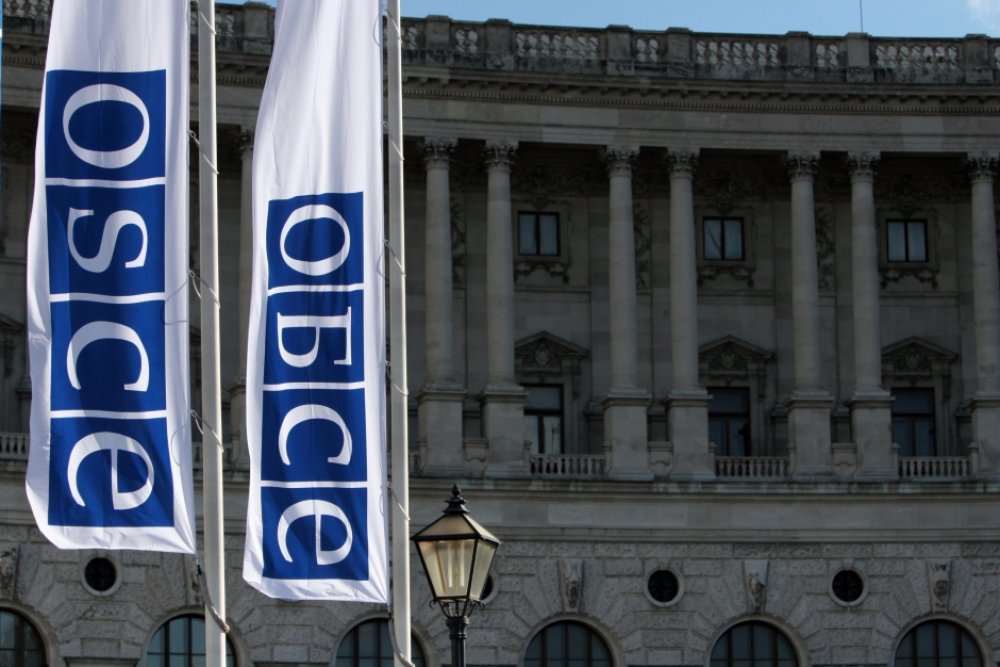Implementation of OSCE Human Dimension Commitments by Italy: Racism, Xenophobia and Anti-Semitism
Introduction
The practice, for States chairing the OSCE, of voluntarily reviewing the implementation status of existing commitments in the human dimension, through an independent report, is a very welcome innovation.
It can add valuable elements to be taken into account also by other specific monitoring tools already existing within the OSCE system. The present paper focuses on the independent report submitted by Italy on selected human rights commitments, and in particular on the issue of recognising, combating and preventing racism, neo-racism, xenophobia and anti-Semitism.
These topics are considered key elements for the development of contemporary societies based on equality and the respect of fundamental human rights.In the report, it has been ascertained that the Italian legislative and institutional framework is fully in line with the OSCE standards and commitments, laid down in the 1990 Copenhagen Document and reiterated afterwards.[1]
But official and unofficial sources frequently report episodes of racism and xenophobia in Italy. A comprehensive picture of the situation, with relevant and general statistical data, is very difficult to obtain, since the analyses available are focused mainly on single grounds of discrimination (e.g. ethnic/racial, religion, sexual orientation).
UNAR (Ufficio Nazionale Antidiscriminazioni Razziali) [2] collects data on this issue through its ‘Contact Center’, as well as the Ministry of Interior, and ISTAT (Italian National Statistics Institute). The OSCE Office for Democratic Institutions and Human Rights (ODIHR) and the European Union Agency for Fundamental Rights (FRA) consider national data in their periodic reports on hate crimes and, more generally, on discrimination in Europe. NGOs and other observers (e.g. Amnesty International, VOX – Osservatorio Italiano sui Diritti) pay constant attention to this issue. Data come from heterogeneous sources, as we may see, but they concur on the steady increase of xenophobic and racist attitudes among Italian people in the very last years.
Using data provided by UNAR for 2017, almost 4000 racist/xenophobic episodes have been registered by its ‘Contact Center’, with an increase of more than 30 % on the information registered in previous years. 91 % of them have been considered as grounded on racial discrimination and/or xenophobia: 73 % classified as ethnic and/or racial discrimination (including 16 % of cases of discrimination against Roma, Sinti and Caminanti), 9,9 % as discrimination based on religious or personal convictions, 9,1 % as discrimination based on sexual orientation and/or gender identity, 4,4 % as discrimination based on disability, 2,4 % as discrimination based on age, 1,2 % as multiple discrimination. [3] In addition, all independent observers show their concern and call for a renewed effort to take effective measures for contrasting this trend.
Assessment on the Implementation of the OSCE Standards and Commitments
The overall activities of Italy on racism, xenophobia and anti-Semitism have been assessed, focusing then on some positive aspects and problematic issues.
The development of National Plans for tackling racism and related intolerance
The idea of adopting national plans for planning different activities under a general set of objectives has been developed gradually among Italian Institutions, and this tool has been put into practice only recently. The definition and implementation of long-term strategic programmes required the starting of processes for the coordination of all governance structures, including institutions at central, regional and local level, civil society, the social partners and all other subjects involved and having competence, in various capacities, on the subject under exam.
Two National Plans of Action against Racism, Xenophobia and Related Intolerance (2013-2015 and 2015-2017) have been adopted, a common – and dynamic – tool to support national and local policies for preventing and fighting racism, xenophobia and intolerance, with a multidisciplinary and multiannual programme of interventions, involving public administrations and civil society, to make effective the principle of equal treatment and non-discrimination among people. However, it has been difficult to praise the actual value of the Plans, because little information on their implementation may be found in public sources and on the media.
In 2012, the Italian government adopted its National Strategy for the Inclusion of Roma, Sinti and Caminanti Communities (NSRI), to overcome definitively the emergency phase pursued by several governments from 2008 to 2011, especially when working on the relevant situation in large urban areas. The NSRI defined a roadmap for public policies between 2012-2020, focused on the gradual elimination of poverty and social exclusion amongst marginalized RSC communities in four main areas: healthcare, education, employment and housing. A gender perspective andnon-discrimination and a human rights-based approach were added as crosscutting principles for the implementation of the Strategy.
A rather critical evaluation of the situation after the adoption of the Strategy can be found in the 2016 ECRI report on Italy.[4]
Serious issues concerning Roma, Sinti and Caminanti Communities (RSC communities) in Italy and the implementation of NSRI have been relaunched by several stakeholders, focusing in particular on the maintaining of residential segregation. According to data collected by NGOs, almost 26000 RSC persons live in segregated camps. Concern over this practice has been expressed by some UN monitoring bodies.[5]
To reverse this trend, a strong political commitment is necessary, followed by adequate funding for actions included in the NSRI. To show a concrete willingness for RSC communities’ integration policies, Italy should at least halt the eviction process and ensure that rehousing plans do not result in new segregated camps. Italy should also review national, regional and municipal housing legislation, policies and practices to ensure that they do not discriminate against RSC persons and prioritize efforts for ensuring access quality education for RSC children. In addition, it is particularly necessary to step up efforts to combat ‘Romaphobia’, which is more and more presented, and perceived as an ‘acceptable racism’.
Hate speech and hate crimes
Episodes of segregation and ‘racial’ and/or ‘cultural’ conflicts are reported, often echoed and fueled by fake news, also through social media. In addition, a significant number of incidents of hate speech by politicians targeting vulnerable groups have been registered by NGOs and media in Italy.[6]
Migrants, women, RSC communities, religious believers (Muslims, followed by Jews), LGBTI people, and persons with disabilities are the groups most targeted by hate speech.The attention of the Italian institutions towards hate speech, which undermines, inter alia, the freedom of expression and information, is growing.
The 2015 Italian Internet Bill of Rights, and the 2017 Anti-Cyberbullying Law are examples of good practice. Prosecution of hate crimes is a priority, and is accompanied by several interventions involving civil society, too. The Italian Camera dei Deputatiset up in the Jo CoxCommission on Intolerance, Xenophobia, Racism and Hatred– named after the British Member of Parliament shot on 16 June 2016 while going to a constituency surgery in Bristall, West Yorkshire (UK) by a man associated to far-right organisations. The Commissionaimed at strengthening the fight against the trend of xenophobic thinking among Italians; its 2017 final reportexamines causes and forms of hate speeches and hate crimes at length, to develop recommendations for preventing and tackling hate speech.
Despite the institutional cooperation against hate speech and hate crimes, it has to be highlighted that criminal complaints are low in number for hate crimes, compared to the number of incidents registered by media and NGOs. The lack of confidence in law enforcement, resignation, fear of reprisals, and privacy issues may be listed among the reasons for abstaining from filing a complaint.
Specific actions on anti-Semitism
In the last years, as FRA showed in its very recent survey on discrimination and hate crime against Jews in the EU, there is a need to reinforce the implementation of measures for the prevention and contrast of Anti-Semitism. As for Italy, the Osservatorio antisemitismoof the Fondazione Centro di Documentazione Ebraica Contemporanea observed that, although racist violence is smaller in numbers, an increase of anti-Semitic expressions (also on the internet) has been registered (from 53 episodes in 2010, to 90 in 2015, and 130 in 2017): reference is made to verbal offenses, insults, threats, vandalism, defamation, and graffiti.
The need for inter-religious dialogue to overcome prejudices and stereotypes and the fight against anti-Semitism, and its ‘new’ forms, are considered as priorities by Italy, even when it is difficult to prosecute those responsible of anti-Semitic acts, in particular for online threats and offences. The International Conference on the Responsibility of States, Institutions and Individuals in the Fight against Anti-Semitism in the OSCE Area, hosted by the Italian 2018 OSCE Chairmanship on 29 January 2018, testified the commitment of Italy for positive action in this field.
Conclusion: awareness-raising as a tool against racism, xenophobia and anti-Semitism
Civil society and NGOs are very active on awareness-raising initiatives, offering a qualified service encouraged by public authorities.
Besides its actions to contrast the phenomena under analysis, Italy should step up its efforts by all institutions, national and local, to respond to racism, xenophobia and anti-Semitism. Instead, in the last months, there are some worrisome signs, in public debates and in political behaviours (even from members of the Government in power), where hate speech is ‘trivialised’ and/or ‘normalized’, and xenophobic acts toward targeted groups (e.g. migrants) do not generate outrage, but are tolerated.
A firm condemnation of all statements and acts of a racist nature by Italian public figures is a keystone in the fight against racism, xenophobia and anti-Semitism, and any step behind would undermine the efforts for developing a society based on equality and non-discrimination.
[1]See, G.C. Bruno, “The implementation of the OSCE Commitments in Italy in Contrast to Racism, Xenophobia and anti-Semitism”, in Implementation of Selected OSCE Commitments on Human Rights and Democracy in Italy. Independent Evaluation Report on the occasion of the Italian OSCE Chairmanship 2018, Sant’Anna School of Advanced Studies, Pisa,pp. 171-202 (http://www.rapitosce2018.santannapisa.it/en/final-report) .
[2]The Office is entrusted with the promotion of equality and the removal of all forms of discrimination, including homophobia and transphobia, with particular attention to multiple and intersecting forms of discriminations in both private and public sectors.
[3]Dati UNAR 2017, UNAR Contact Center (ed.) (updated on 22 June 2018).
[4]European Commission against Racism and Intolerance, ECRI Report on Italy (fifth monitoring cycle). Adopted on 18 March 2016, Doc. CRI(2016)19 of 7 June 2016, pp. 27-8. For the comments of Italian authorities, ibid., pp. 56-8.
[5]Committee on the Elimination of Racial Discrimination, Concluding observations on the combined nineteenth and twentieth periodic reports of Italy, UN Doc. CERD/C/ITA/CO/19-20 of 17 February 2017, para. 21.
[6]See, for updated data, Un’estate all’insegna del razzismo, Lunaria (ed.), Focus N° 6/2018 (www.cronachediordinariorazzismo.it) .
*Dr. Giovanni Carlo Bruno is Researcher in International Law, Institute for Research on Innovation and Services for Development of the National Research Council of Italy, Napoli (Italy).



Comments
* Your email address will not be published